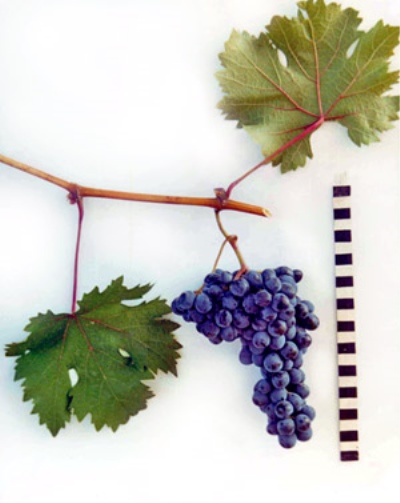
- Authors: VNIIViV them. ME AND. Potapenko. Authors: Syan I.N., Arestov V.P., Khaidu V.I., Sokolova N.I.
- Appointment: technical
- Berry color: Navy blue
- Taste: harmonious, with a nutmeg-honey aroma
- Ripening period: early middle
- Ripening period, days: 135
- Frost resistance, ° C: -26
- Bunch weight, g: 250-300
- Yield: 120-130 c / ha
- Flower type: bisexual
Magic is a technical grape variety. The fruits are mainly used for making wine, but they can also be used for medicinal purposes. For example, from the berries of Magic, they make a medicine for venous expansion, drugs to increase hemoglobin and normalize the psychosomatic state.
Breeding history
The Magic variety was bred at VNIIViV them. Ya.I. Potapenko. It was the result of crossing the varieties of grapes SV 12-309 and Kazachka. The variety was allowed to be used in 2000.
Description
The bush of the presented variety is vigorous, has 18-20 eyes, the leaves are alternate, may have cuts in the shape of a triangle at the tips. Flowers form in June, but sometimes they can begin to appear as early as May. The trunk is yellow or reddish, turns brown with age.
Ripening period
Magic belongs to varieties with an early-medium ripening period, you can eat the first berries after 135 days.
Bunches
The bunches have a cylindrical-conical shape, average density, each weighing 250-300 g.
Berries
The fruit is characterized by a dark blue color and a slightly oval shape. Berry weight - 1.9 g.
Taste
The taste of berries is harmonious, with a nutmeg-honey aroma. Sugar content - 235 g / dm³, acid - 7-8 g / dm³. The pulp of the fruit is fleshy and juicy. Table wine made from the Magic variety receives a tasting score of 7.8 points, dessert wine is rated at 8.6 points.
Yield
The productivity of the Magic variety: from 1 hectare, you can collect 120-130 centners of the crop.


Growing features
It is not difficult to contain Magic grapes. It is undemanding to the type of soil, has a high rooting rate of cuttings and good adhesion with rootstocks. Needs classic care, including pruning, shaping a bush, feeding, treating diseases and pests.
Landing
When choosing a site, give preference to sunny places without shading, it is better to plant on the south or west side. Before planting, it is recommended to hold the seedling in an aqueous solution with a tablespoon of honey for a day.
First, a hole 80x80 cm in size is dug, a nutrient mixture (humus and fertile soil) is placed on the bottom, then mineral fertilizers, the last layer is filled with ordinary earth. The recommended landing pattern is 3x1 m.

Pollination
The presented variety has flowers of both sexes, therefore it does not need other pollinating varieties.
Pruning
Vine pruning is carried out for 3-4 eyes with a bush load of 18-22 shoots.



Frost resistance and the need for shelter
The Magic variety can withstand temperatures down to –26 degrees and does not need insulation for the winter. And even if the bush freezes, then, given its strong growth, it is quickly regenerated by young fruiting shoots.

Diseases and pests
The resistance of the variety to mildew is estimated at 2 points, to mildew - at 3 points. But, for example, in front of phylloxera, the bush is weakly resistant, and therefore needs protection. It is enough to treat the plant with pesticides twice per season.

If a grape is exposed to any disease or insect, this always affects its appearance.
Storage
The berries of the Magic variety are well stored, but for their best marketability it is important to place them correctly in storage. There are several ways:
hanging bunches on a rope so that they do not come into contact with each other;
cutting off fruits with a branch and processing with paraffin;
storage of a brush with a vine in a container with water, like a bouquet;
storage in sand, cork chips, sawdust.
Reviews
Mostly Magic is highly regarded by winegrowers. In their opinion, the taste of the berries is reminiscent of black currant. There is a large size of bunches and high stepson formation, which, for example, is good when decorating gazebos. Home winemakers also like the taste of the drink made from Magic berries. When drinking wine, a floral-honey aroma is felt.











































































